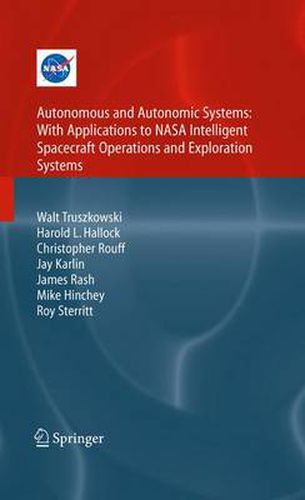Readings Newsletter
Become a Readings Member to make your shopping experience even easier.
Sign in or sign up for free!
You’re not far away from qualifying for FREE standard shipping within Australia
You’ve qualified for FREE standard shipping within Australia
The cart is loading…






This title is printed to order. This book may have been self-published. If so, we cannot guarantee the quality of the content. In the main most books will have gone through the editing process however some may not. We therefore suggest that you be aware of this before ordering this book. If in doubt check either the author or publisher’s details as we are unable to accept any returns unless they are faulty. Please contact us if you have any questions.
In the early 1990s, NASA Goddard Space Flight Center started researching and developing autonomous and autonomic ground and spacecraft control systems for future NASA missions. This research started by experimenting with and developing expert systems to automate ground station software and reduce the number of people needed to control a spacecraft. This was followed by research into agent-based technology to develop autonomous ground c- trol and spacecraft. Research into this area has now evolved into using the concepts of autonomic systems to make future space missions self-managing and giving them a high degree of survivability in the harsh environments in which they operate. This book describes much of the results of this research. In addition, it aimstodiscusstheneededsoftwaretomakefutureNASAspacemissionsmore completelyautonomousandautonomic.Thecoreofthesoftwareforthesenew missions has been written for other applications or is being applied gradually in current missions, or is in current development. It is intended that this book should document how NASA missions are becoming more autonomous and autonomic and should point to the way of making future missions highly - tonomous and autonomic. What is not covered is the supporting hardware of these missions or the intricate software that implements orbit and at- tude determination, on-board resource allocation, or planning and scheduling (though we refer to these technologies and give references for the interested reader).
$9.00 standard shipping within Australia
FREE standard shipping within Australia for orders over $100.00
Express & International shipping calculated at checkout
This title is printed to order. This book may have been self-published. If so, we cannot guarantee the quality of the content. In the main most books will have gone through the editing process however some may not. We therefore suggest that you be aware of this before ordering this book. If in doubt check either the author or publisher’s details as we are unable to accept any returns unless they are faulty. Please contact us if you have any questions.
In the early 1990s, NASA Goddard Space Flight Center started researching and developing autonomous and autonomic ground and spacecraft control systems for future NASA missions. This research started by experimenting with and developing expert systems to automate ground station software and reduce the number of people needed to control a spacecraft. This was followed by research into agent-based technology to develop autonomous ground c- trol and spacecraft. Research into this area has now evolved into using the concepts of autonomic systems to make future space missions self-managing and giving them a high degree of survivability in the harsh environments in which they operate. This book describes much of the results of this research. In addition, it aimstodiscusstheneededsoftwaretomakefutureNASAspacemissionsmore completelyautonomousandautonomic.Thecoreofthesoftwareforthesenew missions has been written for other applications or is being applied gradually in current missions, or is in current development. It is intended that this book should document how NASA missions are becoming more autonomous and autonomic and should point to the way of making future missions highly - tonomous and autonomic. What is not covered is the supporting hardware of these missions or the intricate software that implements orbit and at- tude determination, on-board resource allocation, or planning and scheduling (though we refer to these technologies and give references for the interested reader).